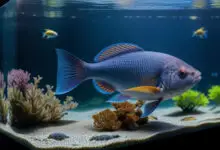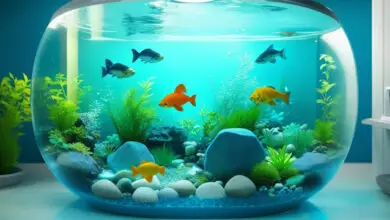Keeping Your Fish Tank Clean and Healthy with Biofilters

Having a fish tank can be a fun and relaxing hobby. Watching the fish swim around and tend to their daily activities can lower stress. However, keeping the water clean and the fish healthy does take some work. One of the most important things you need is a good filtration system, specifically one that uses beneficial bacteria to remove waste and keep the water sparkling. This article will explore biofilters, how they work, the different types, and how to keep them working properly.
What is a Biofilter?
A biofilter is a type of filtration system that uses beneficial bacteria to remove toxic compounds like ammonia and nitrite from the tank water. As fish waste and excess food break down, they release these compounds which are harmful to fish. The biofilter provides a place for colonies of good bacteria to grow. These bacteria convert the toxins into less harmful nitrate. By establishing and maintaining your biofilter, you create a healthy environment for your fish.
Why Are Biofilters Important?
Without a filter, waste would continually buildup in the aquarium leading to poor water quality. At high enough levels, toxins can kill fish. A filter helps remove solid waste but cannot breakdown toxic compounds. That’s where the biofilter comes in. The bacteria in the biofilter provide the biological filtration to convert the dissolved wastes into safer byproducts. This is essential for keeping fish healthy.
How Do Biofilters Work?
Biofilters provide a surface, usually with a very high surface area, where bacteria can attach and colonize. As water passes through, the bacteria convert ammonia first into nitrite, then into less harmful nitrate.
To work properly, a biofilter needs a steady food source of ammonia to grow the beneficial bacteria colonies. In the beginning of a new tank setup, it takes some time for the filter to become properly colonized. Fish waste and decomposing food start providing a source of ammonia to get the bacteria established.
Biofilter Types
There are a few main types of biofilters used in aquariums:
1. Power Filters
Power filters provide mechanical, chemical, and biological filtration in one unit. These hang-on-back filters contain filter media like foam, ceramics, or bioballs that the bacteria adhere to. Water is pulled through the media, filtered, then returned to the tank. Power filters provide a good amount of surface area for bacteria.
2. Canister Filters
Canister filters work similar to power filters but are located underneath the aquarium. Water gets pulled down into stacked trays filled with media like bio-balls, ceramic noodles, sponges, etc. The large volume provides space for an abundance of bacteria. Flow rate and filtration are typically better than power filters.
3. Wet/Dry Trickle Filters
Wet/dry filters, often home made, feature bio-media in a section exposed to air. The water trickles over the media and then drains. The large air exposure promotes growth of bacteria that convert nitrite into nitrate. Great for heavily stocked tanks.
4. Fluidized Bed Filters
Fluidized bed filters use sand or small beads that get suspended by the flow of water through the filter. This agitation increases exposure and oxygenation for the nitrogen cycle bacteria.
Growing the Beneficial Bacteria
When adding a biofilter to a new aquarium, it takes some time for bacteria populations to establish on the filter media. Simply running a filter does not guarantee it can properly handle the fish waste and toxins. You need thriving colonies of bacteria to develop first or ammonia and nitrite can accumulate when fish are added.
The best way to safely grow the bacteria is through the nitrogen cycle process. The steps are:
- Add a source of ammonia – Fish food or pure ammonia works well. This feeds the bacteria.
- Test frequently – Measure for presence of ammonia, nitrite, then nitrate. Beneficial bacteria populations increase and begin converting ammonia > nitrite > nitrate.
- Water changes if needed – Change some water if toxin levels rise too high before the bacteria catch up.
- Add fish once cycles completes – Cycling is finished when ammonia and nitrite both drop to zero and some nitrate registers on tests. Now the tank is ready!
Cycling a tank by slowly growing your biofilter bacteria is the safest way to prevent a harmful ammonia spike that could be deadly when fish are introduced. Be patient and let the bacteria fully colonize before adding your fish.
Maintaining a Healthy Biofilter
Once your aquarium biofilter is fully cycled and established, some regular maintenance will help keep it functioning properly. Follow these tips:
- Avoid replacing all filter media at once – Media like filter pads do decompose over time. However, swapping everything out destroys the good bacteria. Instead, replace media in sections every few months.
- Rinse foam/sponges in removed tank water – When doing a water change, squeeze out dirty filter pads and sponges in the old aquarium water you just removed. This cleans debris without killing bacteria.
- Supplement with commercial bacteria – Adding bottled bacteria products when introducing new fish or after antibiotics can help biofilters recover more quickly.
- Test water parameters regularly – Check that ammonia and nitrite stay at zero to confirm your biofilter is working as intended. High readings mean time to troubleshoot.
- Clean pump impellers – Clean impeller assemblies on power filters ensure good water flow to keep bacteria thriving.
Following a proper aquarium nitrogen cycle to establish the biofilter, combined with good maintenance, provides a healthy, biologically balanced environment for fish to live their best lives!
Frequently Asked Questions About Biofilters
Many new fish owners have some common questions about using biofilters for their tanks. Here are answers to a few frequently asked questions.
Q: Why does my tank need biological media in the filter?
Biological media like ceramic pieces, plastic bio-balls, sponge materials with high surface area provide the sites for beneficial bacteria to attach to and colonize on. Without this media, there are no surfaces for the bacteria responsible for the nitrogen cycle to grow. This can lead to ammonia and nitrite accumulation which is toxic to fish. The bacteria convert the toxins into safer nitrate which gets diluted by water changes.
Q: Do I ever have to replace the biological filter media?
The biological media does not usually need full replacement unless it has become very clogged with debris limiting water flow or suffocating the bacteria. If replacing, just do sections at a time to allow remaining bacteria to repopulate onto the new media. Sometimes materials like sponges or pads do decompose over a long period of use. Rinsing well in tank water during routine filter maintenance extends usefulness. Supplementing with products containing live bacteria when doing major filter cleanings helps biofilters re-establish.
Q: My tank has been running for 3 weeks – why are some fish dying?
It’s likely because the nitrogen cycle in a new tank has not completed and the biofilter is underdeveloped. While mechanical and chemical filtration start right away when a filter runs, it takes time for the crucial bio stage establishing colonies of waste-converting bacteria to occur. Without a fully cycled biofilter, ammonia and nitrite rapidly accumulate when fish are added which can be lethal. Be patient and grow your biofilter first before adding a full stock of fish. Use cycling processes adding ammonia sources, frequent testing, and water changes as needed.
Q: How often should I clean or replace filter media?
For the mechanical media, clean or replace filter pads, floss, sponges, etc. as they trap debris and limit water flowing through the biofilter. Monthly cleaning is fairly typical for power filters in aquariums with light bio-loads. Use tank water to rinse rather than tap water which contains chlorine that kills bacteria. For biological media like bio-balls, ceramic media, etc. these only need a rinse every few months with tank water, no soap cleaners! You want the good bacteria to remain undisturbed. Replace as needed when media starts to deteriorate over a long period like 1-2 years.
Conclusion
The beneficial bacteria that populate biofilters are crucial for maintaining aquarium health by keeping toxic ammonia and nitrite levels in check. Without the “good bugs”, fish waste would accumulate leading to poor water conditions, stress, disease, and death. By properly establishing your biofilter first before stocking your tank, then maintaining the bacteria colonies with good practices, your fish and other aquatic pets will be able to better thrive in a safe habitat. Growing a strong biofilter takes patience but is one of the most important components in the nitrogen cycle process that leads to clear water and happy fish that amaze and delight.







